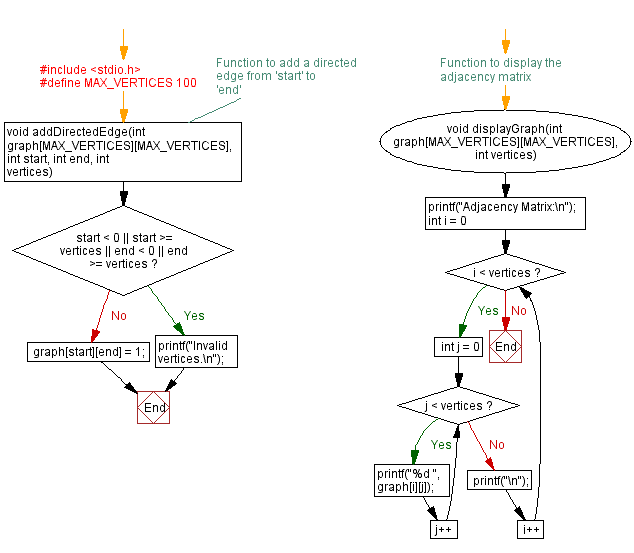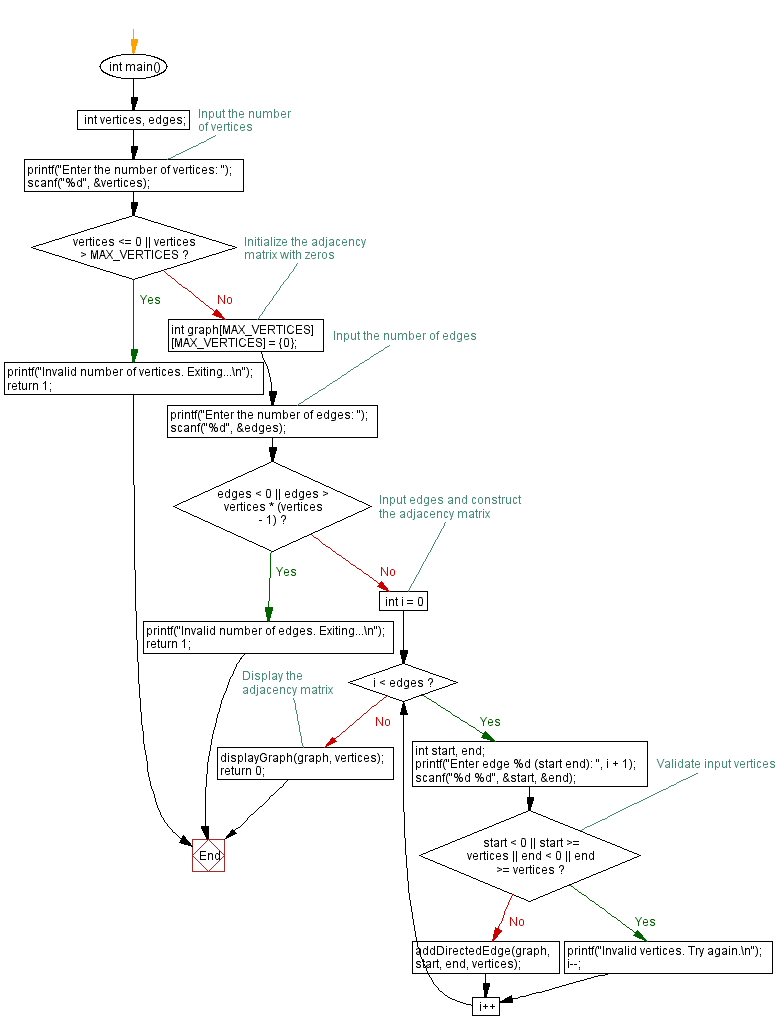C Program to add directed edge in Graph
3. Directed Edge Insertion Challenges
Write a C function to add a directed edge between two vertices in a graph.
Sample Solution:
C Code:
#include <stdio.h>
#define MAX_VERTICES 100
// Function to add a directed edge from 'start' to 'end'
void addDirectedEdge(int graph[MAX_VERTICES][MAX_VERTICES], int start, int end, int vertices) {
if (start < 0 || start >= vertices || end < 0 || end >= vertices) {
printf("Invalid vertices.\n");
return;
}
graph[start][end] = 1;
}
// Function to display the adjacency matrix
void displayGraph(int graph[MAX_VERTICES][MAX_VERTICES], int vertices) {
printf("Adjacency Matrix:\n");
for (int i = 0; i < vertices; i++) {
for (int j = 0; j < vertices; j++) {
printf("%d ", graph[i][j]);
}
printf("\n");
}
}
int main() {
int vertices, edges;
// Input the number of vertices
printf("Enter the number of vertices: ");
scanf("%d", &vertices);
if (vertices <= 0 || vertices > MAX_VERTICES) {
printf("Invalid number of vertices. Exiting...\n");
return 1;
}
int graph[MAX_VERTICES][MAX_VERTICES] = {0}; // Initialize the adjacency matrix with zeros
// Input the number of edges
printf("Enter the number of edges: ");
scanf("%d", &edges);
if (edges < 0 || edges > vertices * (vertices - 1)) {
printf("Invalid number of edges. Exiting...\n");
return 1;
}
// Input edges and construct the adjacency matrix
for (int i = 0; i < edges; i++) {
int start, end;
printf("Enter edge %d (start end): ", i + 1);
scanf("%d %d", &start, &end);
// Validate input vertices
if (start < 0 || start >= vertices || end < 0 || end >= vertices) {
printf("Invalid vertices. Try again.\n");
i--;
continue;
}
addDirectedEdge(graph, start, end, vertices);
}
// Display the adjacency matrix
displayGraph(graph, vertices);
return 0;
}
Output:
Enter the number of vertices: 5 Enter the number of edges: 6 Enter edge 1 (start end): 0 1 Enter edge 2 (start end): 1 2 Enter edge 3 (start end): 2 3 Enter edge 4 (start end): 3 4 Enter edge 5 (start end): 4 0 Enter edge 6 (start end): 2 4 Adjacency Matrix: 0 1 0 0 0 0 0 1 0 0 0 0 0 1 1 0 0 0 0 1 1 0 0 0 0
Explanation:
The above C program represents a directed graph using an adjacency matrix. Here's a brief explanation:
- Function addDirectedEdge:
- Take a graph represented by an adjacency matrix, the start and end vertices of a directed edge, and the total number of vertices.
- Checks if the provided vertices are valid.
- If valid, it adds a directed edge from the 'start' vertex to the 'end' vertex by updating the corresponding entry in the adjacency matrix.
- Function displayGraph:
- Takes a graph represented by an adjacency matrix and the total number of vertices.
- Displays the adjacency matrix on the console.
- Main Function:
- Reads the number of vertices and edges from the user.
- Creates an adjacency matrix initialized with zeros.
- Takes input for directed edges, validates the vertices, and adds them to the graph using the "addDirectedEdge()" function.
- Displays the resulting adjacency matrix.
Flowchart:


For more Practice: Solve these Related Problems:
- Write a C program to add a directed edge between two vertices in an adjacency matrix and check for duplicate edge insertions.
- Write a C program to add a directed edge while preventing self-loops, updating the matrix accordingly.
- Write a C program to implement a function that adds a directed edge with a specified weight and validates the weight range.
- Write a C program to add a directed edge between two vertices and update the corresponding in-degree and out-degree counters.
Go to:
PREV : Add Vertex to Graph Extended Challenges.
NEXT : Depth-First Search (DFS) Extended Challenges.
C Programming Code Editor:
Have another way to solve this solution? Contribute your code (and comments) through Disqus.
What is the difficulty level of this exercise?
Test your Programming skills with w3resource's quiz.
